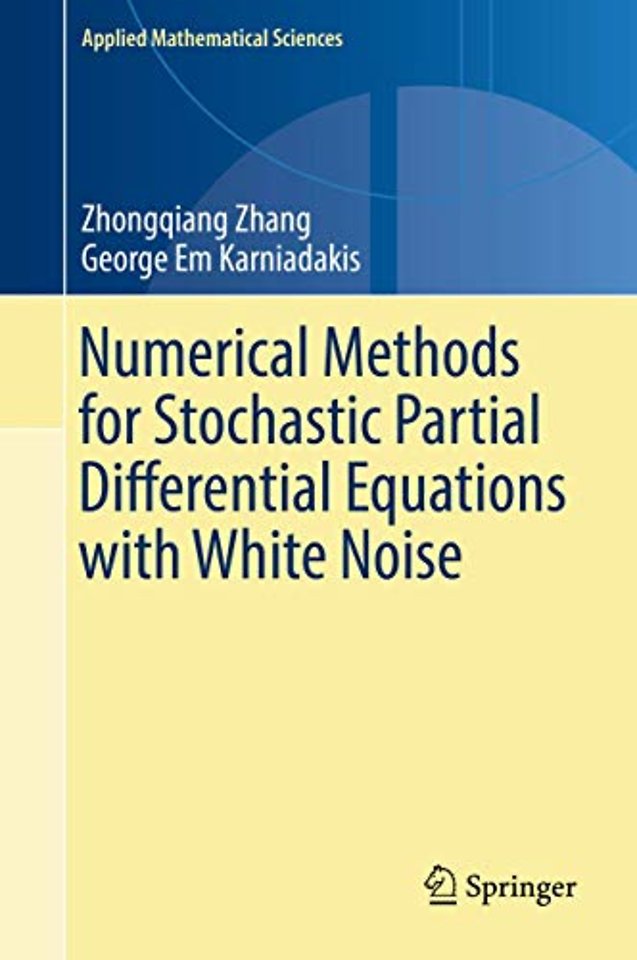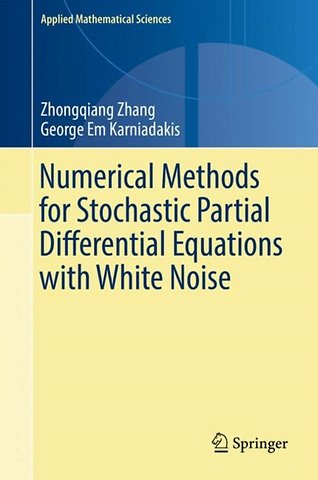Numerical Methods for Stochastic Partial Differential Equations with White Noise
Samenvatting
This book covers numerical methods for stochastic partial differential equations with white noise using the framework of Wong-Zakai approximation. The book begins with some motivational and background material in the introductory chapters and is divided into three parts. Part I covers numerical stochastic ordinary differential equations. Here the authors start with numerical methods for SDEs with delay using the Wong-Zakai approximation and finite difference in time. Part II covers temporal white noise.
Here the authors consider SPDEs as PDEs driven by white noise, where discretization of white noise (Brownian motion) leads to PDEs with smooth noise, which can then be treated by numerical methods for PDEs. In this part, recursive algorithms based on Wiener chaos expansion and stochastic collocation methods are presented for linear stochastic advection-diffusion-reaction equations. In addition, stochastic Euler equations are exploited as an application of stochastic collocation methods, where a numerical comparison with other integration methods in random space is made. Part III covers spatial white noise. Here the authors discuss numerical methods for nonlinear elliptic equations as well as other equations with additive noise. Numerical methods for SPDEs with multiplicative noise are also discussed using the Wiener chaos expansion method. In addition, some SPDEs driven by non-Gaussian white noise are discussed and some model reduction methods (based on Wick-Malliavin calculus) are presented for generalized polynomial chaos expansion methods. Powerful techniques are provided for solving stochastic partial differential equations.
This book can be considered as self-contained. Necessary background knowledge is presented in the appendices. Basic knowledge of probability theory and stochastic calculus is presented in Appendix A. In Appendix B some semi-analytical methods for SPDEs are presented. In Appendix C an introduction to Gauss quadrature is provided. In Appendix D, all the conclusions which are needed for proofs are presented, and in Appendix E a method to compute the convergence rate empirically is included.
In addition, the authors provide a thorough review of the topics, both theoretical and computational exercises in the book with practical discussion of the effectiveness of the methods. Supporting Matlab files are made available to help illustrate some of the concepts further. Bibliographic notes are included at the end of each chapter. This book serves as a reference for graduate students and researchers in the mathematical sciences who would like to understand state-of-the-art numerical methods for stochastic partial differential equations with white noise.
Trefwoorden
Specificaties
Inhoudsopgave
1 Prologue 1
1.1 Why random and Brownian motion (white noise)? 1
1.2 Modeling with SPDEs 4
1.3 Specific topics of this book 7
2 Brownian motion and stochastic calculus 11
2.1 Gaussian processes and their representations 11
2.2 Brownian motion and white noise 17
2.2.1 Some properties of Brownian motion 18
2.2.2 Approximation of Brownian motion 21
2.3 Brownian motion and stochastic calculus 25
2.4 Stochastic chain rule: Ito formula 29
2.5 Integration methods in random space 31
2.5.1 Monte Carlo method and its variants 31
2.5.2 Quasi-Monte Carlo methods 34
2.5.3 Wiener chaos expansion method 35
2.5.4 Stochastic collocation method 37
2.5.5 Application to SODEs 40
2.6 Bibliographic notes 46
2.7 Suggested practice 50
3 Numerical methods for stochastic differential equations 53
3.1 Basic aspects of SODEs 53
3.1.1 Existence and uniqueness of strong solutions 54
3.1.2 Solution methods 56
3.2 Numerical methods for SODEs 60
3.2.1 Derivation of numerical methods based on numerical integration 60
3.2.2 Strong convergence 62
3.2.3 Weak convergence 64
3.2.4 Linear stability 66
3.2.5 Summary of numerical SODEs 69
3.3 Basic aspects of SPDEs 69
3.3.1 Functional spaces 72
3.3.2 Solutions in different senses 73
3.3.3 Solutions to SPDEs in explicit form 76
3.3.4 Linear stochastic advection-diffusion-reaction equations 77
3.3.5 Existence and uniqueness
3.3.6 Conversion between Ito and Stratonovich formulation 78
3.4 Numerical methods for SPDEs 80
3.4.1 Direct semi-discretization methods for parabolic SPDEs 82
3.4.2 Wong-Zakai approximation for parabolic SPDEs 85
3.4.3 Preprocessing methods for parabolic SPDEs 86
3.4.4 What could go wrong? Examples of stochastic Burgers and Navier-Stokes equations 88
3.4.5 Stability and convergence of existing numerical methods 90
3.4.6 Summary of numerical SPDEs. 93
3.5 Summary and bibliographic notes 94
3.6 Suggested practice 96
Part I Numerical Stochastic Ordinary Differential Equations
4 Numerical schemes for SDEs with time delay using the Wong-Zakai approximation 103
4.1 Wong-Zakai approximation for SODEs 104
4.1.1 Wong-Zakai approximation for SDDEs 105
4.2 Derivation of numerical schemes 106
4.2.1 A predictor-corrector scheme 107
4.2.2 The midpoint scheme 111
4.2.3 A Milstein-like scheme 113
4.3 Linear stability of some schemes. 119
4.4 Numerical results 123
4.5 Summary and bibliographic notes 129
4.6 Suggested practice 132
5 Balanced numerical schemes for SDEs with non-Lipschitz coefficients 135
5.1 A motivating example 135
5.2 Fundamental theorem 137
5.2.1 On application of Theorem 5.2.3 140
5.2.2 Proof of the fundamental theorem 141
5.3 A balanced Euler scheme 145
5.4 Numerical examples 153
5.4.1 Some numerical schemes 153
5.4.2 Numerical results 155
5.5 Summary and bibliographic notes 158
5.6 Suggested practice 159
Part II Temporal White Noise
6 Wiener chaos methods for linear stochastic advectiondiffusion reaction equations 165
6.1 Description of methods 165
6.1.1 Multistage WCE method 166
6.1.2 Algorithm for computing moments 170
6.2 Examples in one dimension 173
6.2.1 Numerical results for one-dimensional advectiondiffusion reaction equations 175
6.3 Comparison of the WCE algorithm and Monte Carlo type Algorithms 177
6.4 A two-dimensional passive scalar equation 181
6.4.1 A Monte Carlo method based on the method of characteristics 184
6.4.2 Comparison between recursive WCE and Monte Carlo methods 185
6.5 Summary and bibliographic notes 186
6.6 Suggested practice 188
7 Stochastic collocation methods for differential equations with white noise 191
7.1 Introduction 191
7.2 Isotropic sparse grid for weak integration of SDE 193
7.2.1 Probabilistic interpretation of SCM193
7.2.2 Illustrative examples 194
7.3 Recursive collocation algorithm for linear SPDEs 202
7.4 Numerical results 206
7.5 Summary and bibliographic notes 212
7.6 Suggested practice 214
8 Comparison between Wiener chaos methods and stochastic collocation methods 215
8.1 Introduction 215
8.2 Review of Wiener chaos and stochastic collocation 216
8.2.1 Wiener chaos expansion (WCE) 216
8.2.2 Stochastic collocation method (SCM) 217
8.3 Error estimates . 220
8.3.1 Error estimates for WCE 221
8.3.2 Error estimate for SCM 227
8.4 Numerical results 236
8.5 Summary and bibliographic notes 244
8.6 Suggested practice 245
9 Application of collocation method to stochastic conservation laws 247
9.1 Introduction 247
9.2 Theoretical background 249
9.2.1 Stochastic Euler equations 250
9.3 Verification of the Stratonovich- and Ito-Euler equations. 252
9.3.1 A splitting method for stochastic Euler equations 252
9.3.2 Stratonovich-Euler equations versus first-order perturbation analysis 253
9.3.3 Stratonovich-Euler equations versus Ito-Euler equations 254
9.4 Applying the stochastic collocation method 255
9.5 Summary and bibliographic notes 258
9.6 Suggested practice 261
Part III Spatial White Noise
10 Semilinear elliptic equations with additive noise 267
10.1 Introduction 267
10.2 Assumptions and schemes 269
10.3 Error estimates for strong and weak convergence order 271
10.3.1 Examples of other PDEs 272
10.3.2 Proofs of the strong convergence order 275
10.3.3 Weak convergence order 278
10.4 Error estimates for finite element approximation 282
10.5 Numerical results. 288
10.6 Summary and bibliographic notes 289
10.7 Suggested practice 291
11 Multiplicative white noise: The Wick-Malliavin approximation 293
11.1 Introduction 293
11.2 Approximation using the Wick-Malliavin expansion 295
11.3 Lognormal coefficient 297
11.3.1 One-dimensional example 299
11.4 White noise as coefficient 300
11.4.1 Error Estimates 303
11.4.2 Numerical results 310
11.5 Application of Wick-Malliavin approximation to nonlinear SPDEs 311
11.6 Wick-Malliavin approximation: extensions for non-Gaussian white noise 313
11.6.1 Numerical results 318
11.6.2 Malliavin derivatives for Poisson noises 321
11.7 Summary and bibliographic notes 325
11.8 Suggested practice 329
12 Epilogue 331
12.1 A review of this work 331
12.2 Some open problems 334
Appendices
A Basics of probability 339
A.1 Probability space 339
A.1.1 Random variable 339
A.2 Conditional expectation 340
A.2.1 Properties of conditional expectation 341
A.2.2 Filtration and Martingales 342
A.3 Continuous time stochastic process 343
B Semi-analytical methods for SPDEs 345
C Gauss quadrature 347
C.1 Gauss quadrature 347
C.2 Gauss-Hermite quadrature. 350
D Some useful inequalities and lemmas 353
E Computation of convergence rate 357
References 359
Index 391










